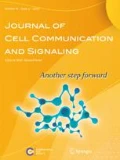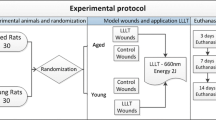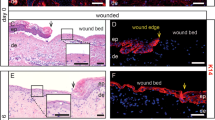Abstract
In skin, the basement membrane at the dermal-epidermal junction (DEJ-BM) is an important structure that tightly binds the epidermis to the dermis, and acts as a permeability barrier that controls exchange of macromolecules. Repair of the DEJ-BM during wound healing is important for restoration of skin functional properties after wounding. Here, we used a CO2 laser to perform partial thickness wounds in human volunteers, and directly compared wound repair in healthy young and aged individuals, focusing on the DEJ-BM. Our results show that the DEJ-BM is restored within four weeks after partial thickness wounds in young adults. We identified laminin-γ2 as preferred substrate for keratinocytes during reepithelialization of partial thickness human wounds. Laminin-γ2 is expressed continuously by migrating keratinocytes during reepithelialization, whereas collagen IV and collagen VII are deposited after wound closure. In contrast, our study shows that the DEJ-BM restoration following wounding is deficient in elderly individuals. Specifically, COL7A2 was barely increased during wound repair in aged skin and, as a result, the DEJ-BM in elderly skin was not restored and showed abnormal structure. Our data suggest that ameliorating the quality of the DEJ-BM restoration is a promising therapeutic approach to improve the quality of repaired skin in the elderly.






Similar content being viewed by others
Abbreviations
- AF:
-
Anchoring fibrils
- BM:
-
Basement membrane
- CO2 :
-
Carbon dioxide
- DEJ-BM:
-
Dermal-epidermal junction basement membrane
- HD:
-
Hemidesmosome
- TEM:
-
Transmission electron microscopy
- IHC:
-
Immunohistochemistry
- LCM:
-
Laser capture microdissection
- LD:
-
Lamina densa
- LL:
-
Lamina lucida
- qPCR:
-
Quantitative real-time RT-PCR
- SEM:
-
Standard error of the mean
References
Amano S (2009) Possible involvement of basement membrane damage in skin photoaging. J Investig Dermatol Symp Proc 14:2–7
Avalone FG (1968) Jones' method for kidney. In: Luna LG (ed) Manual of histologic staining methods of the armed forces institute of pathology. Blakiston division. McGraw-Hill, New York, pp 97–99
Benbow M (2017) Assessment, prevention and management of skin tears. Nurs Older People 29:31–39
Breitkreutz D, Koxholt I, Thiemann K, Nischt R (2013) Skin basement membrane: the foundation of epidermal integrity--bm functions and diverse roles of bridging molecules nidogen and perlecan. BioMed Res Int 2013:179784
Bruckner-Tuderman L (1999) Hereditary skin diseases of anchoring fibrils. J Dermatol Sci 20:122–133
Burgeson RE, Chiquet M, Deutzmann R, Ekblom P, Engel J, Kleinman H, Martin GR, Meneguzzi G, Paulsson M, Sanes J et al (1994) A new nomenclature for the laminins. Matrix Biol 14:209–211
Carter WG, Ryan MC, Gahr PJ (1991) Epiligrin, a new cell adhesion ligand for integrin alpha 3 beta 1 in epithelial basement membranes. Cell 65:599–610
Clark RA, Lanigan JM, DellaPelle P, Manseau E, Dvorak HF, Colvin RB (1982) Fibronectin and fibrin provide a provisional matrix for epidermal cell migration during wound reepithelialization. J Investig Dermatol 79:264–269
Coulombe PA (1997) Towards a molecular definition of keratinocyte activation after acute injury to stratified epithelia. Biochem Biophys Res Commun 236:231–238
Dellambra E, Vailly J, Pellegrini G, Bondanza S, Golisano O, Macchia C, Zambruno G, Meneguzzi G, De Luca M (1998) Corrective transduction of human epidermal stem cells in laminin-5-dependent junctional epidermolysis bullosa. Hum Gene Ther 9:1359–1370
Fine JD, Redmar DA, Goodman AL (1987) Sequence of reconstitution of seven basement-membrane components following split-thickness wound induction in primate skin. Arch Dermatol 123:1174–1178
Freedberg IM, Tomic-Canic M, Komine M, Blumenberg M (2001) Keratins and the keratinocyte activation cycle. J Investig Dermatol 116:633–640
Gagnoux-Palacios L, Vailly J, Durand-Clement M, Wagner E, Ortonne JP, Meneguzzi G (1996) Functional re-expression of laminin-5 in laminin-gamma2-deficient human keratinocytes modifies cell morphology, motility, and adhesion. J Biol Chem 271:18437–18444
Ghohestani RF, Li K, Rousselle P, Uitto J (2001) Molecular organization of the cutaneous basement membrane zone. Clin Dermatol 19:551–562
Ko MS, Marinkovich MP (2010) Role of dermal-epidermal basement membrane zone in skin, cancer, and developmental disorders. Dermatol Clin 28:1–16
Langton AK, Halai P, Griffiths CE, Sherratt MJ, Watson RE (2016) The impact of intrinsic ageing on the protein composition of the dermal-epidermal junction. Mech Ageing Dev 156:14–16
Larjava H, Salo T, Haapasalmi K, Kramer RH, Heino J (1993) Expression of integrins and basement membrane components by wound keratinocytes. J Clin Investig 92:1425–1435
Minner F, Poumay Y (2009) Candidate housekeeping genes require evaluation before their selection for studies of human epidermal keratinocytes. J Investig Dermatol 129:770–773
Natarajan E, Omobono JD 2nd, Jones JC, Rheinwald JG (2005) Co-expression of p16ink4a and laminin 5 by keratinocytes: a wound-healing response coupling hypermotility with growth arrest that goes awry during epithelial neoplastic progression. J Investig Dermatol Symp Proc 10:72–85
Nguyen BP, Ryan MC, Gil SG, Carter WG (2000) Deposition of laminin 5 in epidermal wounds regulates integrin signaling and adhesion. Curr Opin Cell Biol 12:554–562
Orringer JS, Kang S, Johnson TM, Karimipour DJ, Hamilton T, Hammerberg C, Voorhees JJ, Fisher GJ (2004) Connective tissue remodeling induced by carbon dioxide laser resurfacing of photodamaged human skin. Arch Dermatol 140:1326–1332
Rittié L (2016) Cellular mechanisms of skin repair in humans and other mammals. J Cell Commun Signal 10:103–120
Rittié L, Varani J, Kang S, Voorhees JJ, Fisher GJ (2006) Retinoid-induced epidermal hyperplasia is mediated by epidermal growth factor receptor activation via specific induction of its ligands heparin-binding egf and amphiregulin in human skin in vivo. J Investig Dermatol 126:732–739
Rittié L, Kansra S, Stoll SW, Li Y, Gudjonsson JE, Shao Y, Michael LE, Fisher GJ, Johnson TM, Elder JT (2007) Differential erbb1 signaling in squamous cell versus basal cell carcinoma of the skin. Am J Pathol 170:2089–2099
Rittié L, Kang S, Voorhees JJ, Fisher GJ (2008) Induction of collagen by estradiol: difference between sun-protected and photodamaged human skin in vivo. Arch Dermatol 144:1129–1140
Rittié L, Stoll SW, Kang S, Voorhees JJ, Fisher GJ (2009) Hedgehog signaling maintains hair follicle stem cell phenotype in young and aged human skin. Aging Cell 8:738–751
Rittié L, Perbal B, Castellot JJ Jr, Orringer JS, Voorhees JJ, Fisher GJ (2011) Spatial-temporal modulation of ccn proteins during wound healing in human skin in vivo. J Cell Commun Signal 5:69–80
Rittié L, Sachs DL, Orringer JS, Voorhees JJ, Fisher GJ (2013a) Eccrine sweat glands are major contributors to reepithelialization of human wounds. Am J Pathol 182:163–171
Rittié L, Orringer JS, Sachs DL, Voorhees JJ, Fisher GJ (2013b) Eccrine sweat gland-derived keratinocytes rapidly express epidermal differentiation markers during repair of human wounds. J Investig Dermatol 133:S251–S251
Rittié L, Farr EA, Orringer JS, Voorhees JJ, Fisher GJ (2016) Reduced cell cohesiveness of outgrowths from eccrine sweat glands delays wound closure in elderly skin. Aging Cell 15:842–852
Rousselle P, Beck K (2013) Laminin 332 processing impacts cellular behavior. Cell adhesion and. Migration 7:122–134
Ryan MC, Christiano AM, Engvall E, Wewer UM, Miner JH, Sanes JR, Burgeson RE (1996) The functions of laminins: lessons from in vivo studies. Matrix Biol 15:369–381
Stanley JR, Alvarez OM, Bere EW Jr, Eaglstein WH, Katz SI (1981) Detection of basement membrane zone antigens during epidermal wound healing in pigs. J Investig Dermatol 77:240–243
Strazzieri-Pulido KC, Peres GR, Campanili TC, de Gouveia Santos VL (2017) Incidence of skin tears and risk factors: a systematic literature review. Journal of wound, Ostomy and continence. Nursing 44:29–33
Sugawara K, Tsuruta D, Ishii M, Jones JC, Kobayashi H (2008) Laminin-332 and -511 in skin. Exp Dermatol 17:473–480
Villone D, Fritsch A, Koch M, Bruckner-Tuderman L, Hansen U, Bruckner P (2008) Supramolecular interactions in the dermo-epidermal junction zone: anchoring fibril-collagen vii tightly binds to banded collagen fibrils. J Biol Chem 283:24506–24513
Williams MG, Hunter R (1957) Studies on epidermal regeneration by means of the strip method. J Investig Dermatol 29:407–413
Winter GD (1972) Epidermal regeneration studied in the domestic pig. In: Maibach HI, Rovee DT (eds) Epidermal wound healing. Year Book Medical Publishers, Chicago, pp 71–112
Yang S, Sun Y, Geng Z, Ma K, Sun X, Fu X (2016) Abnormalities in the basement membrane structure promote basal keratinocytes in the epidermis of hypertrophic scars to adopt a proliferative phenotype. Int J Mol Med 37:1263–1273
Acknowledgements
We thank Suzan Rehbine, LPN, for her help with volunteer recruitment and tissue collection, Dorothy Sorenson (Microscopy and Image-analysis Laboratory) and for her help with operating the electron microscope. This research was supported by the University of Michigan Dermatology Department research fund, and K01 grant AR059678 from the NIH/NIAMS (to LR). The Microscopy and Image-analysis Laboratory is a multiuser imaging facility supported by the University of Michigan.
Author information
Authors and Affiliations
Corresponding author
Rights and permissions
About this article
Cite this article
Fisher, G., Rittié, L. Restoration of the basement membrane after wounding: a hallmark of young human skin altered with aging. J. Cell Commun. Signal. 12, 401–411 (2018). https://doi.org/10.1007/s12079-017-0417-3
Received:
Accepted:
Published:
Issue Date:
DOI: https://doi.org/10.1007/s12079-017-0417-3




